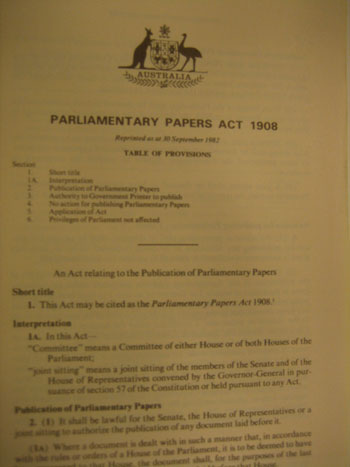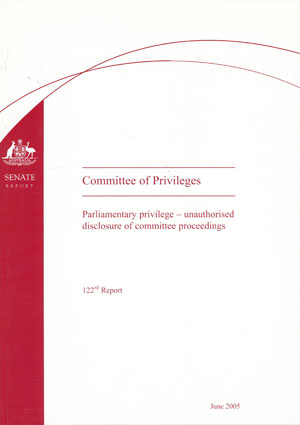General committee provisions
37 Disclosure of evidence and documents
-
The evidence taken by a committee and documents presented to it, which have not been reported to the Senate, shall not, unless authorised by the Senate or the committee, be disclosed to any person other than a member or officer of the committee.
-
A senator who wishes to refer to in camera evidence or unpublished committee documents in a dissenting report shall advise the committee of the evidence or documents concerned, and all reasonable effort shall be made by the committee to reach agreement on the disclosure of the evidence or documents for that purpose. If agreement is not reached, the senator may refer to the in camera evidence or unpublished documents in the dissent only to the extent necessary to support the reasoning of the dissent. Witnesses who gave the evidence or provided the documents in question shall, if practicable, be informed in advance of the proposed disclosure of the evidence or documents and shall be given reasonable opportunity to object to the disclosure and to ask that particular parts of the evidence or documents not be disclosed. The committee shall give careful consideration to any objection by a witness before making its decision. Consideration shall be given to disclosing the evidence or documents in such a way as to conceal the identity of persons who gave the evidence or provided the documents or who are referred to in the evidence or documents.
-
-
The President is authorised to permit any person to examine and copy evidence submitted to, or documents of, committees, which are in the custody of the Senate, which have not already been published by the Senate or its committees, and which have been in the Senate’s custody for at least 10 years.
-
If such evidence or documents were taken in camera or submitted on a confidential or restricted basis, disclosure shall not take place unless the evidence or documents have been in the custody of the Senate for at least 30 years, and, in the opinion of the President, it is appropriate that such evidence or documents be disclosed.
-
The President shall report to the Senate the nature of any evidence or documents made available under this standing order and the person or persons to whom they have been made available.
Amendment history
Adopted: Paragraph (1) adopted 19 August 1903 as SO 300 but renumbered as SO 296 for the first printed edition.
Amended:
- 7 April 1970, J.49 (to remove conflict with the Parliamentary Papers Act)
- 13 February 1997, J.1447 (to take effect 24 February 1997) (to incorporate orders of continuing effect on the disclosure of in camera evidence and old committee documents – paragraphs (2) and (3))
- 29 April 1999, J.815 (use of unpublished documents in dissenting reports)
1989 revision: Old SO 308 renumbered as SO 37 and repositioned from old chapter XXII on select committees; expression clarified
Commentary

The Parliamentary Papers Act 1908 gave committees the power to authorise publication of their evidence and documents
When SO 37 was briefly debated in 1903, Senator Gould (FT, NSW) summed up its purpose as follows:
I think this standing order is designed to render it impossible for a member of a select committee to go behind the backs of his fellow committeemen and make a disclosure to an outside person.[1]
President Baker had been intending to move an amendment to add a proviso (“unless the Senate otherwise orders”) to the prohibition but decided it was unnecessary. In 1908 the Parliamentary Papers Act was passed which, among other things, declared that it was lawful for a committee to authorise the publication of evidence to it or any document laid before it. The Standing Orders Committee considered that there was potential conflict between the Act and the standing order which, at that stage, required evidence and documents to be reported to the Senate first. On its recommendation, the standing order was amended to add the proviso “unless authorised by the Senate or the Committee”, confirming a committee’s power to publish evidence and documents.[2]
In the 1989 revision of what is now paragraph (1) the emphasis was altered from the person making the disclosure (“shall not…be disclosed or published by any member of such Committee, or by any other person”) to the person receiving it (“shall not…be disclosed to any person other than a member or officer of the committee”). The Senate may treat an unauthorised disclosure of committee proceedings as a contempt.[3]

The Privileges Committee's122nd Report set out procedures to be followed by committees in investigating cases of possible unauthorised disclosure
In 1989, the Senate referred to the Procedure Committee the issue of disclosure of in camera evidence. While there were clear methods for the disclosure of such evidence by order of the Senate or of a committee (or by the inclusion of the evidence in a committee report), it was not clear whether in camera evidence could be disclosed in a dissenting report. Paragraph (8) of Privilege Resolution 1 relating to the protection of witnesses required a committee to inform a witness whether it intended to publish in camera evidence and that, in any case, no binding guarantee could be given that the evidence would not be disclosed by order of the committee or the Senate in the future. The Procedure Committee identified the basis for concern about the disclosure of in camera evidence in dissenting reports and the competing interests involved, but could not agree on where the balance should be struck. Nonetheless, the committee suggested guidelines which could apply to senators wishing to refer to in camera evidence in dissenting reports and recommended that the Senate endorse these guidelines.[4] The report was debated on 23 August 1990 and referred back to the committee for further consideration.[5] The committee refined the guidelines for disclosure of in camera evidence in dissenting reports and these were adopted by the Senate as an order of continuing effect on 13 February 1991, and subsequently incorporated into the 1997 consolidation as paragraph (2).[6]
A further amendment was made to paragraph (2) in 1999 on the adoption of the Procedure Committee’s First Report of 1999 (PP No. 57/1999) on 29 April 1999. This added unpublished committee documents to the category of material subject to special procedures before reference could be made to it in dissenting reports. The suggestion for this change had been made by the Privileges Committee in its 74th Report (PP No. 180/1998) as a further option for reducing the incidence of, and opportunities for, unauthorised disclosures.
Paragraph (3) originated in an order of the Senate of 6 September 1984,[7] incorporated into the standing order by the 1997 consolidation. The 1984 order was an augmented version of a resolution agreed to by both Houses on 22 May 1980[8] which covered old committee documents of a routine nature but had not addressed the issue of in camera evidence or confidential documents. The augmented resolution was recommended by the Standing Orders Committee in its First Report for the Sixty–First Session.[9] The committee recommended that the President be given a discretion to authorise access to in camera committee evidence and documents on the same basis as that proposed in the Archives Bill 1983 (shortly to become the Archives Act 1983); namely, after a period of 30 years. Routine committee material was already subject to a 10 year withholding period under the joint resolution. Requests for access within the relevant withholding periods would continue to require a resolution of the Senate. Part of the 1984 order applied to joint committees and was sent to the House of Representatives for its concurrence. That part of the order continues to operate separately as an order of continuing effect in relation to joint committees. It authorises the President and Speaker to make decisions on the release of joint committee documents of the same types as covered by paragraph (3).[10]